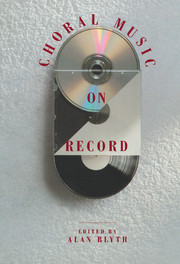Book contents
- Frontmatter
- Contents
- Preface
- Monteverdi: Vespers (1610)
- J.S. Bach: St John Passion
- J.S. Bach: St Matthew Passion
- J.S. Bach: Mass in B Minor
- Handel: Messiah
- Mozart: Requiem Mass
- Haydn: The Creation
- Haydn: The Seasons
- Beethoven: Missa Solemnis
- Mendelssohn: Elijah
- Rossini: Stabat mater Petite messe solennelle
- Berlioz: Grande Messe des Morts Te Deum L'Enfance du Christ
- Verdi: Requiem Mass
- Brahms: A German Requiem
- Fauré: Requiem
- Elgar: The Dream of Gerontius
- Walton: Belshazzar's Feast, Tippett: A Child of Our Time, Britten: War Requiem
- Stravinsky: The Wedding Symphony of Psalms
- Janáček: Glagolitic Mass
- Discographies
- Index
Verdi: Requiem Mass
Published online by Cambridge University Press: 02 December 2009
- Frontmatter
- Contents
- Preface
- Monteverdi: Vespers (1610)
- J.S. Bach: St John Passion
- J.S. Bach: St Matthew Passion
- J.S. Bach: Mass in B Minor
- Handel: Messiah
- Mozart: Requiem Mass
- Haydn: The Creation
- Haydn: The Seasons
- Beethoven: Missa Solemnis
- Mendelssohn: Elijah
- Rossini: Stabat mater Petite messe solennelle
- Berlioz: Grande Messe des Morts Te Deum L'Enfance du Christ
- Verdi: Requiem Mass
- Brahms: A German Requiem
- Fauré: Requiem
- Elgar: The Dream of Gerontius
- Walton: Belshazzar's Feast, Tippett: A Child of Our Time, Britten: War Requiem
- Stravinsky: The Wedding Symphony of Psalms
- Janáček: Glagolitic Mass
- Discographies
- Index
Summary
Toscanini's interpretation of the Verdi Requiem was once described, by Alec Robertson, as the Old Testament reading, Giulini's (his first) as the New Testament, an apt and illustrative distinction that sums up, if too simplistically, the impression left by these two classic performances of the work. ‘Dramatic’ as compared with ‘devotional’ might be another description of their differences. Yet, for all this contrast in approach, there is a greater similarity between the two Italians than there is between their performances and those by many other conductors who have challenged their ascendancy. Indeed with three notable and unexpected exceptions, it is the Italians who come closest to understanding the spirit of the work and to conveying it in a truthful and unexaggerated manner. I use those two epithets advisedly, for it is on fidelity to Verdi's text, particularly to his dynamic and tempi markings, that the success of so many of the most cogent interpretations rests, whether those interpretations be dramatic or devotional.
To show just how much licence some conductors have taken, compare the time taken in two sets from the start of the work to the entry of the tenor soloist. Sir John Barbirolli, one of the most dilatory of all interpreters, begins at crotchet = 50 (instead of Verdi's 80) and allows himself 6 minutes 13 seconds over the passage. Toscanini, conforming to the composer's tempo in his 1951 version, goes through the same music in 4 minutes 33 seconds, an amazing difference, when you consider the section is only of seventy-seven bars length.
- Type
- Chapter
- Information
- Choral Music on Record , pp. 186 - 205Publisher: Cambridge University PressPrint publication year: 1991



